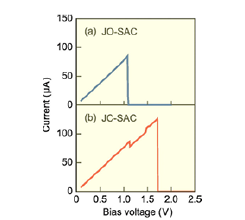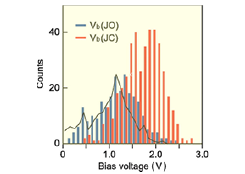Atomic Contacts Easily Broken by Bias Voltage under Tensile Stress
S. Kurokawa, Y. Hasegawa, and A. Sakai
A single-atom contact (SAC) of a metal is the smallest contact where a single atom makes a link between a pair of electrodes. One notable characteristic of SACs is found in their conductance, which is described as (Σnτn)G0. Here τn is the transmission probability of the n-th conduction channel and G0 = 2e2/h is the quantum conductance. Among various metals, SACs of noble metals (Au, Ag, and Cu) are of particular physical and practical importance, because they have only a single conduction channel with τ1 ~ 1, making the conductance ~G0; a material-independent constant. These unique characteristic makes them useful in logic circuits, and some atomic devices employing SACs as functional elements have already been developed.

Fig. 1. Examples of I–V curves observed at Au SACs produced (a) by junction opening (JO) and (b) by junction closing (JC). The junction current increases linearly up to the high-bias breakdown.

Fig. 2. The distribution of the junction breaking voltages of Au SACs. The blue and red histograms represent the distributions for JO- and JC-SACs, respectively. The solid line indicates the Vb data for JO-SACs collected by Smit et al. [3] The distribution of JC (red) is obviously shifted to the high bias side compared to that of JO (blue). The observed high-bias shift of Vb for JC indicates high stability of JC-SACs against the bias voltage applied across the junction.
For the device applications, SACs have to be stable under operating bias voltages. Conventionally, the stability of SACs is discussed in terms of their lifetime τ, which is given by the following thermal-activation-type-formula: τ = τ0eW/kT; W = W0-αV-βF (α, β > 0), where τ0 is a pre-exponential factor, V and F represent the bias and the tensile force applied to an SAC, respectively, and W0 is the activation barrier at V = F = 0. The term αV represents the reduction of the barrier by the bias voltage. Similarly, the term βF determines the ultimate tensile strength to break the SAC.
In the equation, both V and F additively contribute to reduce the activation barrier and shorten the lifetime, which means that the bias stability depends on the amount of F. To date, the bias stability has been experimentally studied for some metal SACs that had been, in most cases, prepared by mechanical breaking, which is usually subjected to built-in tensile stress. In this work [1], we investigated the break voltages of Au and Pb SACs created by junction closing (JC), instead of breaking, and compared the results with those produced by junction opening (JO) or breaking. Because JC essentially involves no junction stretching, the JC-SACs should contain lower tensile forces than JO-SACs and are thus expected to show higher break voltages.
Our break-voltage measurements were made on Au contacts produced by mechanically controllable break junction (MCBJ) method at 4 K. We also performed similar break-voltage experiments on Pb SACs using a cryogenic ultrahigh-vacuum STM at 1.7 K and fabricated Pb SACs by touching a Pb-coated tungsten tip to a clean Pb surface [2].
Figures 1(a) and 1(b) show examples of the I–V curves observed for JO- and JC-SACs, respectively. In both I–V curves, the junction current increases with the voltage and suddenly drops to zero at the point of break junction. From the breaking point we determined the break voltage Vb. Figure 2 summarizes the results of our Vb measurements on Au SACs. In the figure, the two histograms colored in blue and red represent the distributions of Vb for JO- and JC-SACs, respectively. Both histograms cover a wide voltage range, but the distribution of JC (red) is obviously shifted to the high bias side compared to that of JO (blue). The observed high-bias shift of Vb for JC confirms our assumption that JC-SACs show higher break voltages than JO-SACs.
We also measured the break voltages of Pb SACs. The Vb distribution of JC moves to the high bias side relative to that of JO. Thus, as for Au, the JC-SACs of Pb tend to break at higher biases than the JO-SACs. The observed high-bias shift of JC indicates that JC is a viable method for improving the bias stability of SACs.
From our results we also estimated the magnitude of the force reduction in our Au JC-SACs. According to the equation mentioned above, a variation in the tensile force ΔF is related to the variation in the break voltage ΔVb as ΔF = -(α/β)ΔVb. Our ΔVb for Au SACs is 0:52 V. Substituting the value of α and β adapted from Ref. 3, we obtain the force reduction ΔF = 0:15 nN. Smit et al. [3] estimated F in JO is 0.95 nN; thus, we find F in JC is 0.80 nN. This indicates that the JC reduced the tensile force as expected, but the force was still positive and remained tensile.
The tensile force in JC might appear counter-intuitive because a JC-SAC is formed by the touching of two electrodes. We consider that it is due to the short-range attractive force. At the close distances the apex atom moves towards the counter electrode by the attractive force exerted on the atom. As a result, the bonds between the contact atom and the electrode atoms are slightly stretched and exert a tensile force on the contact atom. This explains why we obtained tensile force for our Au JC-SACs.
Our break voltage measurements of Au and Pb SACs indicated that the JC-SACs exhibit a higher break voltage than the JO-SACs, which is favorable for the device application. The improved tolerance against the bias voltage can be understood by the reduced tensile stress in JC-SACs, clarifying the interplay between the junction force and the bias stability in SACs.
References
- [1] S. Wakasugi, S. Kurokawa, H. Kim, Y. Hasegawa, and A. Sakai, J. Appl. Phys. 121, 244304 (2017).
- [2] H. Kim and Y. Hasegawa, Phys. Rev. Lett. 114, 206801 (2015).
- [3] R. H. M. Smit, C. Untiedt, and J. M. van Ruitenbeek, Nanotechnology 15, S472 (2004).
